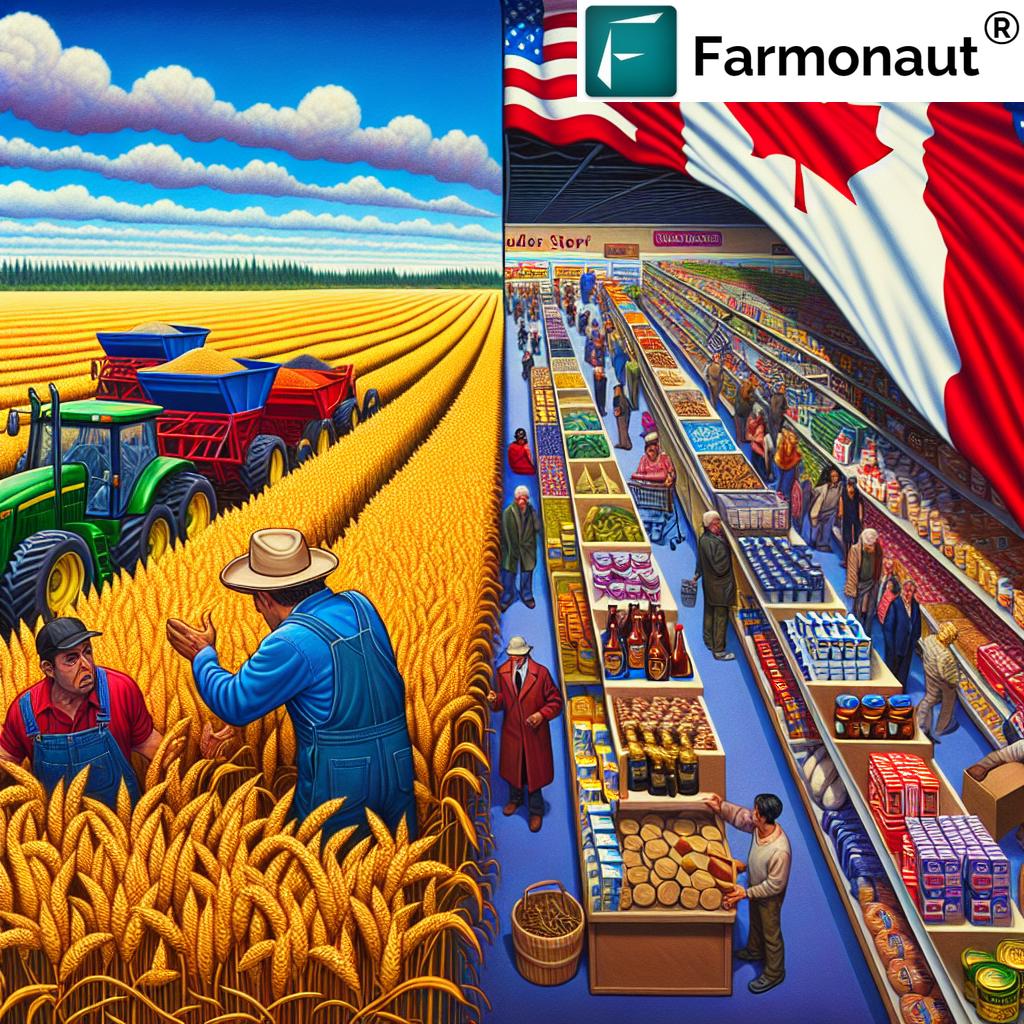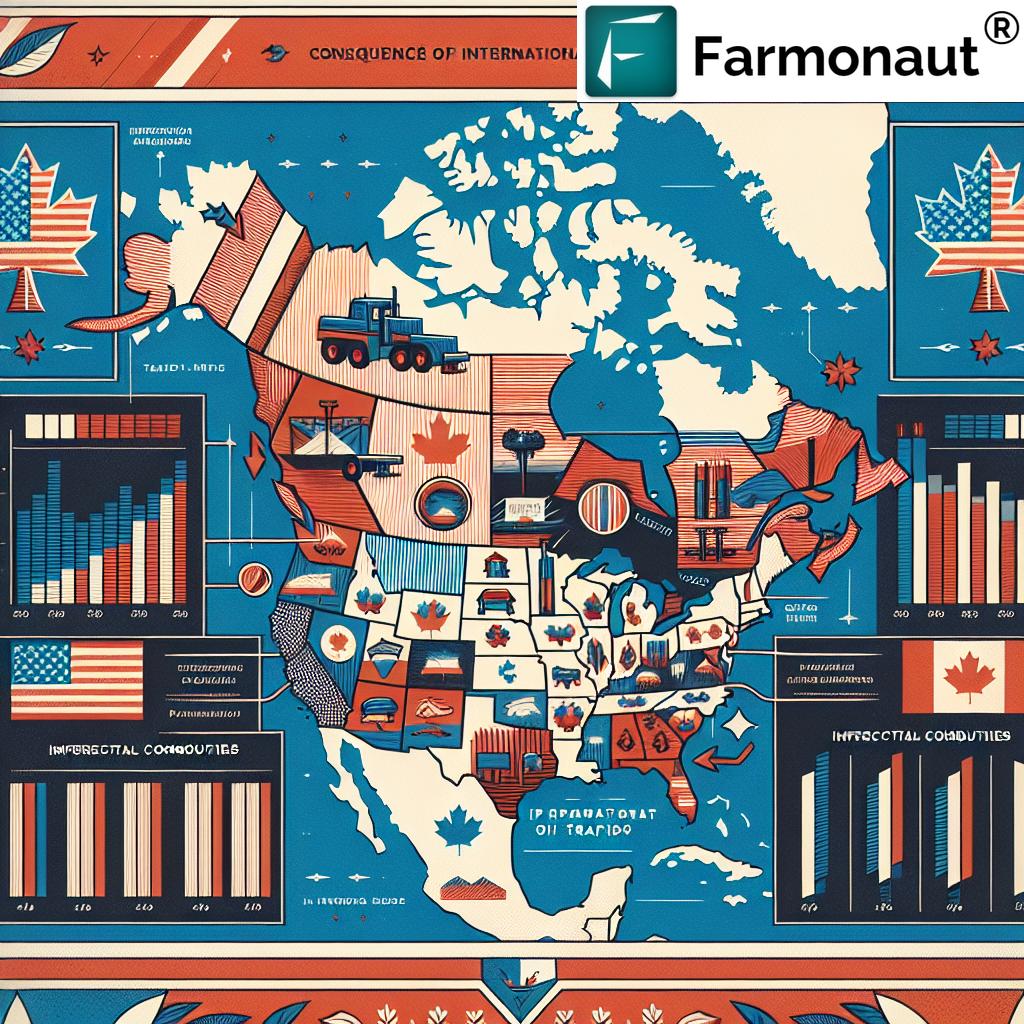How Canada’s Retaliatory Tariffs Impact Agriculture: Farmers Face New Challenges in US-Canada Trade Tensions
“Canada’s retaliatory tariffs target $155 billion worth of American products, impacting various sectors including agriculture.”
In the ever-evolving landscape of international trade, we find ourselves at a critical juncture as Canada and the United States engage in a heated trade dispute. This Canada-US trade dispute has far-reaching implications, particularly for the agricultural sector on both sides of the border. As we delve into the complexities of this situation, we’ll explore how Canadian tariffs on US goods are reshaping the economic landscape and presenting new challenges for farmers and consumers alike.

The Escalation of US-Canada Trade Tensions
The recent announcement by Prime Minister Justin Trudeau has sent shockwaves through the North American economic landscape. In response to the United States’ decision to implement 25 percent tariffs on Canadian goods, Canada has taken a firm stance by preparing to impose retaliatory measures. These Canadian tariffs on US goods are set to target a staggering $155 billion worth of American products, encompassing a wide range of items from alcohol and furniture to various natural resources.
This escalation in US-Canada trade tensions marks a significant turning point in the relationship between these long-standing trade partners. The decision to implement these retaliatory trade measures comes as a direct response to what Canada perceives as unfair trade practices by the United States. As we navigate through this complex situation, it’s crucial to understand the broader implications of these tariffs, particularly on the agricultural sector.
The Agricultural Sector Under Pressure
The Canadian Federation of Agriculture has expressed deep concern over the impending tariffs, highlighting the potential negative consequences for farmers and consumers on both sides of the border. This sentiment underscores the interconnected nature of the North American agricultural market and the delicate balance that exists between producers and consumers across the region.
- Increased costs for farmers
- Potential disruptions in supply chains
- Changes in consumer buying patterns
- Shifts in crop production and livestock management
As we consider the impact of tariffs on consumers, it’s worth noting that technologies like those offered by Farmonaut can help farmers navigate these challenging times. By providing real-time crop health monitoring and AI-driven insights, Farmonaut empowers farmers to make data-driven decisions that can help mitigate some of the economic pressures brought on by these trade tensions.
The “Buy Local” Movement Gains Momentum
In light of these trade tensions, we’re witnessing a surge in the “buy local” movement across Canada. Ontario Premier Doug Ford’s announcement to remove American products from Liquor Control Board of Ontario (LCBO) shelves serves as a prime example of this shift towards promoting local consumption. This move not only impacts the alcohol industry but also sets a precedent for other sectors, including agriculture.
The push to prioritize Ontario-made and Canadian-made products presents both challenges and opportunities for local farmers and producers. While it may lead to increased demand for domestic goods, it also requires rapid adaptation to meet this demand and potentially fill gaps left by reduced imports.
Key benefits of the “buy local” movement:
- Support for local economies
- Reduced carbon footprint due to shorter transportation distances
- Increased food security and sovereignty
- Preservation of local agricultural traditions and practices
For farmers looking to capitalize on this trend, leveraging technologies like Farmonaut’s satellite-based farm management solutions can provide a competitive edge. These tools offer valuable insights that can help optimize crop yields and resource management, crucial factors in meeting increased local demand efficiently.
Cross-Border Trade Relations: A Delicate Balance
The ongoing saga of cross-border trade relations between Canada and the United States highlights the delicate nature of international trade agreements. President Trump’s assertion that the U.S. does not require Canadian resources, specifically mentioning energy, automobiles, and lumber, has added fuel to the fire of this trade dispute.
This rhetoric has not only strained diplomatic relations but has also created uncertainty in various sectors, particularly agriculture. Farmers on both sides of the border are now faced with the challenge of navigating a rapidly changing trade landscape while maintaining their livelihoods.
| Agricultural Sector | Estimated Tariff Rate (%) | Potential Economic Impact ($USD Millions) | Key Affected Products |
|---|---|---|---|
| Dairy | 15-25% | 250-300 | Cheese, Milk, Yogurt |
| Grain | 10-20% | 150-200 | Wheat, Corn, Soybeans |
| Fruits and Vegetables | 20-30% | 300-350 | Apples, Berries, Tomatoes |
| Meat Products | 15-25% | 200-250 | Beef, Pork, Poultry |
As we can see from the table above, the potential economic impact of these tariffs on various agricultural sectors is significant. Farmers and agribusinesses must be prepared to adapt to these changes quickly. This is where innovative solutions like those offered by Farmonaut can play a crucial role.
The Role of Technology in Navigating Trade Challenges
In these uncertain times, technology can serve as a beacon of hope for farmers grappling with the effects of trade tensions. Farmonaut’s suite of tools, including real-time crop health monitoring and AI-based advisory systems, can help farmers optimize their operations and make informed decisions in the face of market volatility.
- Satellite-based crop monitoring for precise resource management
- AI-driven insights for optimizing crop yields
- Blockchain-based traceability for enhancing supply chain transparency
- Resource management tools for efficient farm operations
By leveraging these technologies, farmers can better position themselves to weather the storm of trade disputes and potentially even find new opportunities in a changing market landscape.
The Consumer Perspective: Navigating Changing Prices and Choices
“The US-Canada trade dispute affects cross-border shopping, potentially altering grocery prices for millions of consumers in both countries.”
As the trade war unfolds, consumers on both sides of the border are bracing for potential changes in product availability and prices. The impact of tariffs on consumers is expected to be felt most acutely in sectors like groceries, where cross-border shopping has long been a common practice for many border communities.
Federal Liberal party candidate Chrystia Freeland’s call for Canadians to consciously choose Canadian-made goods reflects a growing sentiment of economic patriotism. This shift in consumer behavior could have lasting effects on the agricultural sector, potentially reshaping demand patterns and supply chains.
Adapting to the New Normal: Strategies for Farmers
In the face of these challenges, farmers must adapt to survive and thrive. Here are some strategies that can help agricultural producers navigate the new landscape:
- Diversification: Exploring new crops or products to reduce reliance on heavily tariffed items
- Technology Adoption: Utilizing advanced farming technologies to improve efficiency and reduce costs
- Local Market Focus: Capitalizing on the “buy local” trend by strengthening connections with domestic consumers
- Value-Added Products: Developing processed or specialty products to increase profit margins
- Collaborative Efforts: Joining forces with other farmers to share resources and knowledge
Farmonaut’s platform can be particularly helpful in implementing these strategies. For instance, its satellite-based crop health monitoring can aid in diversification efforts by providing insights into optimal crop choices for specific land parcels.
The Broader Economic Implications
The ripple effects of this trade dispute extend far beyond the agricultural sector. As both nations brace for potential economic fallout, we’re likely to see impacts across various industries:
- Manufacturing: Potential disruptions in supply chains and increased costs for raw materials
- Retail: Changes in consumer buying patterns and possible price increases
- Transportation and Logistics: Shifts in trade routes and volumes
- Financial Services: Fluctuations in currency exchange rates and trade financing
These broader economic implications underscore the interconnected nature of modern economies and the far-reaching consequences of trade policy changes.
Looking Ahead: The Future of US-Canada Agricultural Trade
As we look to the future, the path forward for US-Canada agricultural trade remains uncertain. However, several key factors will likely shape the landscape:
- Ongoing negotiations and potential policy adjustments
- Technological advancements in agriculture and supply chain management
- Shifting consumer preferences and the continued growth of the “buy local” movement
- Climate change and its impact on agricultural production
In this evolving landscape, staying informed and adaptable will be crucial for all stakeholders in the agricultural sector. Farmers, in particular, can benefit from embracing technologies that provide real-time insights and data-driven decision-making capabilities.
Earn With Farmonaut: Affiliate Program
Earn 20% recurring commission with Farmonaut’s affiliate program by sharing your promo code and helping farmers save 10%. Onboard 10 Elite farmers monthly to earn a minimum of $148,000 annually—start now and grow your income!
Conclusion: Navigating the Storm
The Canada-US trade dispute and the resulting retaliatory tariffs have created a complex and challenging environment for the agricultural sector. As farmers face new challenges in US-Canada trade tensions, adaptability, innovation, and resilience will be key to success.
By staying informed about international trade policy changes, leveraging advanced technologies like those offered by Farmonaut, and remaining responsive to shifting market dynamics, farmers and agricultural businesses can navigate these turbulent waters. While the road ahead may be uncertain, the agricultural sector has always been characterized by its ability to adapt and innovate in the face of challenges.
As we continue to monitor the situation, one thing remains clear: the resilience and ingenuity of farmers on both sides of the border will play a crucial role in shaping the future of North American agriculture.

FAQs
- Q: How will Canadian tariffs on US goods affect food prices for consumers?
A: Canadian tariffs on US goods are likely to increase prices for affected products, potentially leading to higher food costs for consumers. However, the extent of the impact may vary depending on the specific products and the ability of local producers to meet demand. - Q: What can farmers do to mitigate the impact of these trade tensions?
A: Farmers can consider diversifying their crops, adopting cost-saving technologies like those offered by Farmonaut, focusing on local markets, and exploring value-added products to mitigate the impact of trade tensions. - Q: How long are these retaliatory tariffs expected to last?
A: The duration of these tariffs is uncertain and depends on ongoing negotiations between Canada and the US. Trade disputes can be resolved quickly or persist for extended periods, depending on various political and economic factors. - Q: Will the “buy local” movement significantly impact international trade in agriculture?
A: While the “buy local” movement may boost demand for domestic products, international trade will likely remain significant in agriculture due to factors like climate, growing seasons, and specialized production capabilities in different regions. - Q: How can technology help farmers navigate these trade challenges?
A: Technologies like Farmonaut’s satellite-based crop monitoring and AI-driven insights can help farmers optimize their operations, make data-driven decisions, and potentially find new market opportunities amidst changing trade dynamics.

















